Good literature does so many things! It affords the enjoyment of escaping our world and entering the character’s world. It engages us with a fictional character to the extent that we laugh and cry with and for that character. Good literature offers guidance and comfort as we realize we are not alone in our struggles but are a part of a great continuum of human experience. It might compel us to take action for a social, political, or environmental cause. It makes us think about our experience or beyond our experience with new insight. The books reviewed in this column definitely encourage us to linger with them and think about the meanings we take from them.
Ages 4–8
Boats for Papa. Jessixa Bagley. 2015. Roaring Brook.
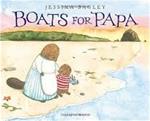 Buckley and his mama are a beaver family of two who live together in a little cabin near the ocean. Buckley loves the beach, and he collects driftwood to carve boats with painstaking care. He makes all kinds of boats, and each one is more beautiful than the last. When he finishes a boat, Buckley sends it out to sea with a note that reads: “For Papa, Love Buckley.” If the boat doesn’t come back, it’s his proof that it found its way to his missing Papa. On his birthday, Buckley makes the most beautiful boat of all, but he realizes that he forgot to write a note to his papa. Searching for paper, he discovers Mama’s secret: She has been collecting his boats all along. The final page of the book allows readers to discover, along with Mama, the note that Buckley wrote for his special boat: “For Mama, Love Buckley.” The endpapers extend the story further: Mama and Buckley are displaying his boat collection on shelves hung on the cabin walls. Bagley’s gentle story of loss and a mother’s love offers a tender invitation to readers to think about how Mama ended up with all of Buckley’s boats and why he decided to address the last note to his mama. The pen-and-watercolor artwork is awash in blue and brown tones, giving readers the feel of being at the ocean with Buckley and Mama.
Buckley and his mama are a beaver family of two who live together in a little cabin near the ocean. Buckley loves the beach, and he collects driftwood to carve boats with painstaking care. He makes all kinds of boats, and each one is more beautiful than the last. When he finishes a boat, Buckley sends it out to sea with a note that reads: “For Papa, Love Buckley.” If the boat doesn’t come back, it’s his proof that it found its way to his missing Papa. On his birthday, Buckley makes the most beautiful boat of all, but he realizes that he forgot to write a note to his papa. Searching for paper, he discovers Mama’s secret: She has been collecting his boats all along. The final page of the book allows readers to discover, along with Mama, the note that Buckley wrote for his special boat: “For Mama, Love Buckley.” The endpapers extend the story further: Mama and Buckley are displaying his boat collection on shelves hung on the cabin walls. Bagley’s gentle story of loss and a mother’s love offers a tender invitation to readers to think about how Mama ended up with all of Buckley’s boats and why he decided to address the last note to his mama. The pen-and-watercolor artwork is awash in blue and brown tones, giving readers the feel of being at the ocean with Buckley and Mama.
–LDP
I (Don't) Like Snakes. 2015. Nicola Davies. Ill. by Luciano Lozano. Candlewick.
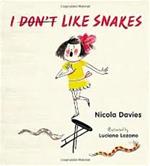 The young girl in this hybrid text, which blends fiction with information, lives with a family who loves snakes. This is challenging for her because she “really, really, REALLY” doesn’t! For each reason she offers for her dislike, a family member shares a fascinating fact explaining why snakes behave as they do. Each new explanation about snakes and their captivating characteristics persuades the girl a little bit more. At the end of the book, her family finally succeeds in converting her: She “really, really, REEEEEALLLLY” likes snakes! Two fonts signal to readers whether fiction or facts are being presented. The back matter includes a note about snakes, a bibliography, and an index. Luciano Lozano’s colorful mixed-media illustrations bring the fictional story and the informational details to life. This book would make a clever mentor text for classroom animal reports, encouraging readers and writers to think deeply about the creative ways to present both narratives and information. Nicola Davies is a highly versatile author. She has a lift-the-flap (Uncover & Discover) informational series for very young readers, many informational picture books for young readers (such as Just Ducks!), an informational book for older readers (Tiny Creatures: The World of Microbes) a fiction picture book for older readers (The Promise), an illustrated novel for older readers (The Lion Who Stole My Arm), and a collection of nature poetry (Outside Your Window: A First Book of Nature).
The young girl in this hybrid text, which blends fiction with information, lives with a family who loves snakes. This is challenging for her because she “really, really, REALLY” doesn’t! For each reason she offers for her dislike, a family member shares a fascinating fact explaining why snakes behave as they do. Each new explanation about snakes and their captivating characteristics persuades the girl a little bit more. At the end of the book, her family finally succeeds in converting her: She “really, really, REEEEEALLLLY” likes snakes! Two fonts signal to readers whether fiction or facts are being presented. The back matter includes a note about snakes, a bibliography, and an index. Luciano Lozano’s colorful mixed-media illustrations bring the fictional story and the informational details to life. This book would make a clever mentor text for classroom animal reports, encouraging readers and writers to think deeply about the creative ways to present both narratives and information. Nicola Davies is a highly versatile author. She has a lift-the-flap (Uncover & Discover) informational series for very young readers, many informational picture books for young readers (such as Just Ducks!), an informational book for older readers (Tiny Creatures: The World of Microbes) a fiction picture book for older readers (The Promise), an illustrated novel for older readers (The Lion Who Stole My Arm), and a collection of nature poetry (Outside Your Window: A First Book of Nature).
–LDP
Sonya’s Chickens. Phoebe Wahl. 2015. Penguin Random House.
 Sonya is given the task of raising three baby chicks on her family’s farm. She takes her duties as their mama seriously. Under her watchful care, they soon grow to be hens. But one day a fox takes one of her beloved friends. Sonya is devastated until her father gently explains that the fox needed to feed his kits, just as she once fed her young chicks. Readers, along with Sonya, are asked to consider the needs of all creatures, not just those under our personal care. This consideration helps Sonya make peace with her loss. The book ends on a hopeful note when Sonya discovers a new egg hatching in the henhouse. Wahl handles the truth of loss gently and realistically. Her full-spread watercolor, collage, and colored pencil illustrations bring Sonya’s story to life, saturating the pages in color and emotion.
Sonya is given the task of raising three baby chicks on her family’s farm. She takes her duties as their mama seriously. Under her watchful care, they soon grow to be hens. But one day a fox takes one of her beloved friends. Sonya is devastated until her father gently explains that the fox needed to feed his kits, just as she once fed her young chicks. Readers, along with Sonya, are asked to consider the needs of all creatures, not just those under our personal care. This consideration helps Sonya make peace with her loss. The book ends on a hopeful note when Sonya discovers a new egg hatching in the henhouse. Wahl handles the truth of loss gently and realistically. Her full-spread watercolor, collage, and colored pencil illustrations bring Sonya’s story to life, saturating the pages in color and emotion.
–LDP
This Is Sadie. 2015. Sara O’Leary. Ill. Julie Morstad. Tundra.
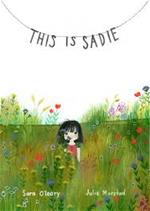 Sadie has an exceedingly well-developed imagination, which she uses to turn a box into a boat and a cushion into a castle. She has grand adventures traveling to fairy-tale worlds with her friends from her favorite books. Readers are invited to discover the magic of stories because, just like Sadie, they “can make them from nothing at all.” Albert Einstein once said: “Imagination is more important than knowledge. Knowledge is limited. Imagination encircles the world.” I believe Sadie would wholeheartedly agree. The book ends with the message: “This is Sadie. And this is her story.” The ending would make a wonderful beginning for readers turned writers: “This is ___________. And this is my story.” A clever connection can be found on the back flap, where readers will discover that the author’s bio begins with “This is Sara,” and the illustrator’s bio begins similarly with “This is Julie.” Julie Morstad’s fanciful illustrations, rendered in gouache, watercolor, and pencil crayon give life to Sadie’s rich imaginings. Fans of Morstad’s art will want to read her book How To, which would pair beautifully with Sadie’s story.
Sadie has an exceedingly well-developed imagination, which she uses to turn a box into a boat and a cushion into a castle. She has grand adventures traveling to fairy-tale worlds with her friends from her favorite books. Readers are invited to discover the magic of stories because, just like Sadie, they “can make them from nothing at all.” Albert Einstein once said: “Imagination is more important than knowledge. Knowledge is limited. Imagination encircles the world.” I believe Sadie would wholeheartedly agree. The book ends with the message: “This is Sadie. And this is her story.” The ending would make a wonderful beginning for readers turned writers: “This is ___________. And this is my story.” A clever connection can be found on the back flap, where readers will discover that the author’s bio begins with “This is Sara,” and the illustrator’s bio begins similarly with “This is Julie.” Julie Morstad’s fanciful illustrations, rendered in gouache, watercolor, and pencil crayon give life to Sadie’s rich imaginings. Fans of Morstad’s art will want to read her book How To, which would pair beautifully with Sadie’s story.
–LDP
Waiting. Kevin Henkes. 2015. Greenwillow.
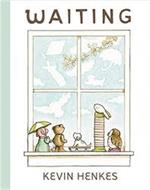 Kevin Henkes, the winner of a Caldecott Medal for Kitten’s First Full Moon, as well as a Caldecott Honor and two Newbery Honors, has gifted readers with a gentle story about the concept of waiting. Five figurines sit on a windowsill looking out the window. Each little toy (a pig, a bear, a puppy, a rabbit, and an owl) waits for something different: the unique experience that makes it happy. The seasons pass, bringing the toys many wonderful sights. A surprise visitor makes an appearance, one who “didn’t seem to be waiting for anything in particular…” until readers learn that the visitor is a nesting doll, bringing the total toy family count to 10! Nestled within the big idea of waiting are small moments reflecting joy, surprise, and sadness. In Waiting, just as in his other books, Henkes never talks down to his child readers. He respects their ability to contemplate big ideas and eloquently captures the tension between waiting, wishing, and acceptance. Childhood is steeped in waiting, and many children (like many adults) have a hard time waiting for what they want. Henkes invites readers to thoughtfully explore the philosophy of waiting in a way that is relevant to their world, through the familiar lens of toys. The illustrations, rendered in muted shades using ink, watercolor, and pencil, evoke an old-fashioned feeling, one that reflects the timelessness of waiting.
Kevin Henkes, the winner of a Caldecott Medal for Kitten’s First Full Moon, as well as a Caldecott Honor and two Newbery Honors, has gifted readers with a gentle story about the concept of waiting. Five figurines sit on a windowsill looking out the window. Each little toy (a pig, a bear, a puppy, a rabbit, and an owl) waits for something different: the unique experience that makes it happy. The seasons pass, bringing the toys many wonderful sights. A surprise visitor makes an appearance, one who “didn’t seem to be waiting for anything in particular…” until readers learn that the visitor is a nesting doll, bringing the total toy family count to 10! Nestled within the big idea of waiting are small moments reflecting joy, surprise, and sadness. In Waiting, just as in his other books, Henkes never talks down to his child readers. He respects their ability to contemplate big ideas and eloquently captures the tension between waiting, wishing, and acceptance. Childhood is steeped in waiting, and many children (like many adults) have a hard time waiting for what they want. Henkes invites readers to thoughtfully explore the philosophy of waiting in a way that is relevant to their world, through the familiar lens of toys. The illustrations, rendered in muted shades using ink, watercolor, and pencil, evoke an old-fashioned feeling, one that reflects the timelessness of waiting.
–LDP
The Whisper. Pamela Zagarenski. 2015. Houghton Mifflin Harcourt for Young Readers.
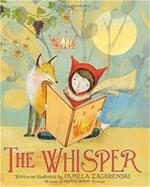 What happens to a story when the words float away and all that remains are the illustrations to tell the story? A little girl who loves stories borrows a magical book from her teacher. On her way home, the letters and words escape from the pages of the book and become caught up in a net of a nearby fox. The girl is filled with disappointment when she discovers the missing words, but a whisper of encouragement soon persuades her to weave her own stories for the wordless illustrations. She discovers the magic of storytelling, using her imagination to create her own unique stories. On her way back to school, the fox strikes a bargain with the girl and the words of the book are restored. Readers may join the girl in thinking deeply about the pictures, creating their own stories alongside the girl’s. The gorgeous mixed-media paintings in this fable celebrate the joy of reading and the power of imagination. Zagarenski is the winner of two Caldecott Honors for her illustrations in Red Sings From Treetops: A Year in Colors, written by Joyce Sidman, and Sleep Like a Tiger, written by Mary Logue. The Whisper, Zagarenski’s first venture into writing, is reminiscent of Chris Van Allsburg’s The Mysteries of Harris Burdick.
What happens to a story when the words float away and all that remains are the illustrations to tell the story? A little girl who loves stories borrows a magical book from her teacher. On her way home, the letters and words escape from the pages of the book and become caught up in a net of a nearby fox. The girl is filled with disappointment when she discovers the missing words, but a whisper of encouragement soon persuades her to weave her own stories for the wordless illustrations. She discovers the magic of storytelling, using her imagination to create her own unique stories. On her way back to school, the fox strikes a bargain with the girl and the words of the book are restored. Readers may join the girl in thinking deeply about the pictures, creating their own stories alongside the girl’s. The gorgeous mixed-media paintings in this fable celebrate the joy of reading and the power of imagination. Zagarenski is the winner of two Caldecott Honors for her illustrations in Red Sings From Treetops: A Year in Colors, written by Joyce Sidman, and Sleep Like a Tiger, written by Mary Logue. The Whisper, Zagarenski’s first venture into writing, is reminiscent of Chris Van Allsburg’s The Mysteries of Harris Burdick.
–LDP
Ages 9–11
Child Soldier: When Boys and Girls Are Used in War. Jessica Dee Humphreys & Michel Chikwanine. 2015. Ill. Claudia Dávila. Kids Can Press.
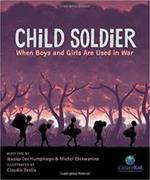 In 1993, 5-year-old Michael Chikwanine was playing with friends after school when he was abducted by a group of rebel soldiers in the Democratic Republic of Congo. This graphic novel chronicles his life before his abduction, his terrifying experience as a child soldier, and his life after escaping the rebel soldiers and eventually immigrating to Canada. Integral to Michel’s story is that of his father, who was a human rights lawyer. Dávila’s muted palette and occasional bright accents complement the text that conveys the horrors and atrocities child soldiers witness and commit in a straightforward way through Michel’s first-person perspective. Back matter includes information about child soldiers, what is being done on a global, national, and ground level to try to stop the practice, and specific things child readers might do as activists. Young readers will linger over the graphic panels and will be left thinking about the plight of child soldiers, the difficulty of moving beyond trauma, and the importance of standing up for causes in which one believes.
In 1993, 5-year-old Michael Chikwanine was playing with friends after school when he was abducted by a group of rebel soldiers in the Democratic Republic of Congo. This graphic novel chronicles his life before his abduction, his terrifying experience as a child soldier, and his life after escaping the rebel soldiers and eventually immigrating to Canada. Integral to Michel’s story is that of his father, who was a human rights lawyer. Dávila’s muted palette and occasional bright accents complement the text that conveys the horrors and atrocities child soldiers witness and commit in a straightforward way through Michel’s first-person perspective. Back matter includes information about child soldiers, what is being done on a global, national, and ground level to try to stop the practice, and specific things child readers might do as activists. Young readers will linger over the graphic panels and will be left thinking about the plight of child soldiers, the difficulty of moving beyond trauma, and the importance of standing up for causes in which one believes.
–LTP
Ages 12–14
Mechanica. Betsy Cornwell. 2015. Clarion/Houghton Mifflin Harcourt.
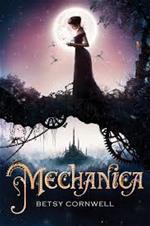 For centuries, readers and authors have been drawn to Cinderella tales, with their orphaned protagonist, wicked stepmother, unkind stepsisters, and handsome prince. Mechanica is a steampunk offering sure to please. On her 16th birthday, Nicolette discovers her dead mother’s hidden workshop and begins to create helpful, and perhaps magical, contraptions. She hopes to be recognized as an inventor and to find a sponsor at the king’s Cultural Exposition Gala. Mechanica (Nicolette) dreams of escaping her life of drudgery and creating a life of security and purpose; she does not dream of marrying the prince. This Cinderella needs no fairy godmother, but two friends support her in her quest. Cornwell eschews the traditional romance trope, focusing instead on a protagonist who charts her own destiny. Recommend this title to fans of Cinder (Meyer, 2011). Mechanica makes us think about created families versus families of origin, the many different guises of love, the importance of possibility, and the dangers of us–them binaries.
For centuries, readers and authors have been drawn to Cinderella tales, with their orphaned protagonist, wicked stepmother, unkind stepsisters, and handsome prince. Mechanica is a steampunk offering sure to please. On her 16th birthday, Nicolette discovers her dead mother’s hidden workshop and begins to create helpful, and perhaps magical, contraptions. She hopes to be recognized as an inventor and to find a sponsor at the king’s Cultural Exposition Gala. Mechanica (Nicolette) dreams of escaping her life of drudgery and creating a life of security and purpose; she does not dream of marrying the prince. This Cinderella needs no fairy godmother, but two friends support her in her quest. Cornwell eschews the traditional romance trope, focusing instead on a protagonist who charts her own destiny. Recommend this title to fans of Cinder (Meyer, 2011). Mechanica makes us think about created families versus families of origin, the many different guises of love, the importance of possibility, and the dangers of us–them binaries.
–LTP
Orbiting Jupiter. Gary D. Schmidt. 2015. Clarion.
 When Joseph joins Jake’s family as a foster son, Jake knows three things about him: he tried to kill a teacher, he spent time in a juvenile detention center, and he has a daughter. In crisp prose and with his signature use of personification, Gary D. Schmidt takes readers into the hearts and heartaches of these two young boys. They become more than foster brothers as Jake helps Joseph find his daughter Jupiter. Not since The First Part Last (Johnson, 2003) has an author so poignantly captured the love between a young father and his daughter. Although some adults stereotype Joseph, the majority is refreshingly supportive and fosters his significant potential. Schmidt deftly guides readers through devastation to hope. Orbiting Jupiter leaves readers thinking about the harmful and limiting nature of stereotypes, the inescapable, destructive families into which some children are born, the power of brotherhood, and the transcendence of love.
When Joseph joins Jake’s family as a foster son, Jake knows three things about him: he tried to kill a teacher, he spent time in a juvenile detention center, and he has a daughter. In crisp prose and with his signature use of personification, Gary D. Schmidt takes readers into the hearts and heartaches of these two young boys. They become more than foster brothers as Jake helps Joseph find his daughter Jupiter. Not since The First Part Last (Johnson, 2003) has an author so poignantly captured the love between a young father and his daughter. Although some adults stereotype Joseph, the majority is refreshingly supportive and fosters his significant potential. Schmidt deftly guides readers through devastation to hope. Orbiting Jupiter leaves readers thinking about the harmful and limiting nature of stereotypes, the inescapable, destructive families into which some children are born, the power of brotherhood, and the transcendence of love.
–LTP
Ages 15+
Kissing in America. Margo Rabb. 2015. Harper/HarperCollins.
 In the two years since her father died in a plane crash, Eva has read 118 romance novels (she’s counting). She falls in love after kissing the mysterious Will and begins to see a way through her grief. When Will moves from New York City to Los Angeles, Eva concocts a plan to travel across the United States with her best friend to see him. The bus trip is eventful, echoing the romance novels Eva loves. She is surrounded by well-drawn, complex characters who love her, but she is so “griefy” that she cannot recognize their griefs. Poems by Elizabeth Bishop, Emily Dickinson, Adrienne Rich, Nikki Giovanni, Marie Howe, and others begin each section of the novel, beautifully reflecting Eva’s emotional needs. Rabb masterfully lightens the novel with Eva’s snarky, witty humor. Readers are left to think about the nature of heartache, how all-consuming grief need not consume us, how adults sometimes make terrible mistakes with good intentions, the importance of women defining and living fulfilling lives, living with questions rather than expecting answers, and the many manifestations of mothers and mothering.
In the two years since her father died in a plane crash, Eva has read 118 romance novels (she’s counting). She falls in love after kissing the mysterious Will and begins to see a way through her grief. When Will moves from New York City to Los Angeles, Eva concocts a plan to travel across the United States with her best friend to see him. The bus trip is eventful, echoing the romance novels Eva loves. She is surrounded by well-drawn, complex characters who love her, but she is so “griefy” that she cannot recognize their griefs. Poems by Elizabeth Bishop, Emily Dickinson, Adrienne Rich, Nikki Giovanni, Marie Howe, and others begin each section of the novel, beautifully reflecting Eva’s emotional needs. Rabb masterfully lightens the novel with Eva’s snarky, witty humor. Readers are left to think about the nature of heartache, how all-consuming grief need not consume us, how adults sometimes make terrible mistakes with good intentions, the importance of women defining and living fulfilling lives, living with questions rather than expecting answers, and the many manifestations of mothers and mothering.
–LTP
The Walls Around Us. Nova Ren Suma. 2015. Algonquin Young Readers.
Violet is a rising, Julliard-bound ballerina. Orianna, her lifelong friend, is convicted of the brutal murders of two other ballerinas and sent to Aurora Hills Secure Juvenile Detention Center. There, her life intertwines with Amber, who was found guilty of orchestrating her stepfather’s death. Told in Violet’s and Amber’s voices, secrets and truths weave in and out of the intersections of the girls’ stories in this ghostly tale of the supernatural. Simultaneously macabre and heartbreakingly beautiful, this novel leaves readers pondering the unequal treatment the rich and the poor receive in the criminal justice system, the gossamer veil that separates the living and the dead, the relativity of guilt and innocence, the power of the lies we tell ourselves, and what it means to pay for one’s crimes. The distinct voices, focused prose, and masterfully crafted final twist are reminiscent of We Were Liars (Lockhart, 2014).
–LTP
Linda T. Parsons is an associate professor in the Department of Teaching and Learning on the Marion Campus of The Ohio State University, where she specializes in middle childhood literacy and young adult literature. Lisa D. Patrick is a literacy coach trainer at The Ohio State University’s Literacy Collaborative, where she specializes in children’s literature and early literacy.
The review contributions are provided by members of the International Literacy Association’s Children’s Literature and Reading Special Interest Group.